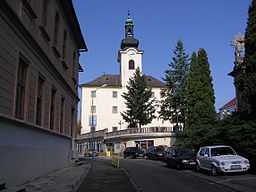Nová Baňa
| Nová Baňa | ||
| Town | ||
 Town Hall in Nová Baňa | ||
|
||
| Country | Slovakia | |
|---|---|---|
| Region | Banská Bystrica | |
| District | Žarnovica | |
| Tourism region | Tekov | |
| River | Hron | |
| Elevation | 221 m (725 ft) | |
| Coordinates | 48°25′28″N 18°38′21″E / 48.42444°N 18.63917°E | |
| Area | 61.25 km2 (23.65 sq mi) | |
| Population | 7,334 (2005) | |
| Density | 120 / km2 (311 / sq mi) | |
| First mentioned | 1337 | |
| Mayor | Jan Havran | |
| Timezone | CET (UTC+1) | |
| - summer (DST) | CEST (UTC+2) | |
| Postal code | 96801 | |
| Area code | +421-45 | |
| Car plate | ZC | |
  Location of Nová Baňa in Slovakia
| ||
  Location of Nová Baňa in the Banská Bystrica Region
| ||
| Wikimedia Commons: Nová Baňa | ||
| Statistics: MOŠ/MIS | ||
| Website: www.novabana.sk | ||
Nová Baňa (German: Königsberg; Hungarian: Újbánya) is a small town in the west of central Slovakia and the largest town of the Žarnovica District, located in the Banská Bystrica Region.
Geography
Nová Baňa lies in right bank of Hron river. Nová Baňa region is surrounded by a ring of volcanic mountains (Štiavnica Mountains on the east, Pohronský Inovec on the south-west and Vtáčnik on the north-west). Seven kilometers from Nová Baňa, close by the village Tekovská Breznica, is the youngest volcano in Central Europe called Putnikov vŕšok.
History
Mining in this area started as early as in the 13th century. In 1337 it was first mentioned under the names Nove Montanie (hence the name Nová Baňa - "new mine") and Seunych. In that year, (probably German) burghers from Kremnica and Pukanec settled here, because gold was discovered in the area. In 1345 Nová Baňa became a "free royal mining town". The mines were closed down in 1887.
Demographics
According to the 2001 census, the town had 7,505 inhabitants. 97.51% of inhabitants were Slovaks, 0.85 Ukrainians and 0.48% Czechs.[1] The religious makeup was 82.53% Roman Catholics, 11.50% people with no religious affiliation and 1.00% Orthodox.[1]
References
- ↑ 1.0 1.1 "Municipal Statistics". Statistical Office of the Slovak republic. Archived from the original on 2007-11-16. Retrieved 2007-12-15.
External links
| |||||||
